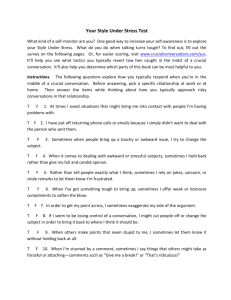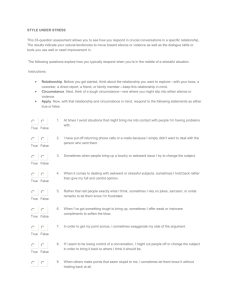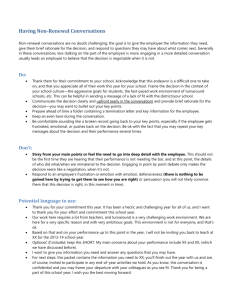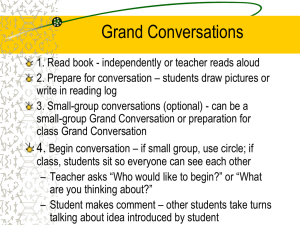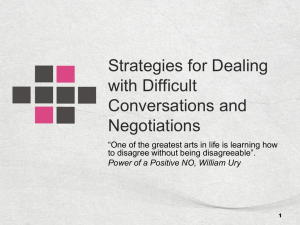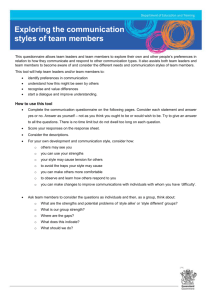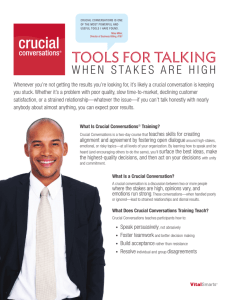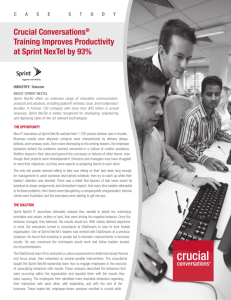YOUR STYLE UNDER STRESS TEST - UW
advertisement
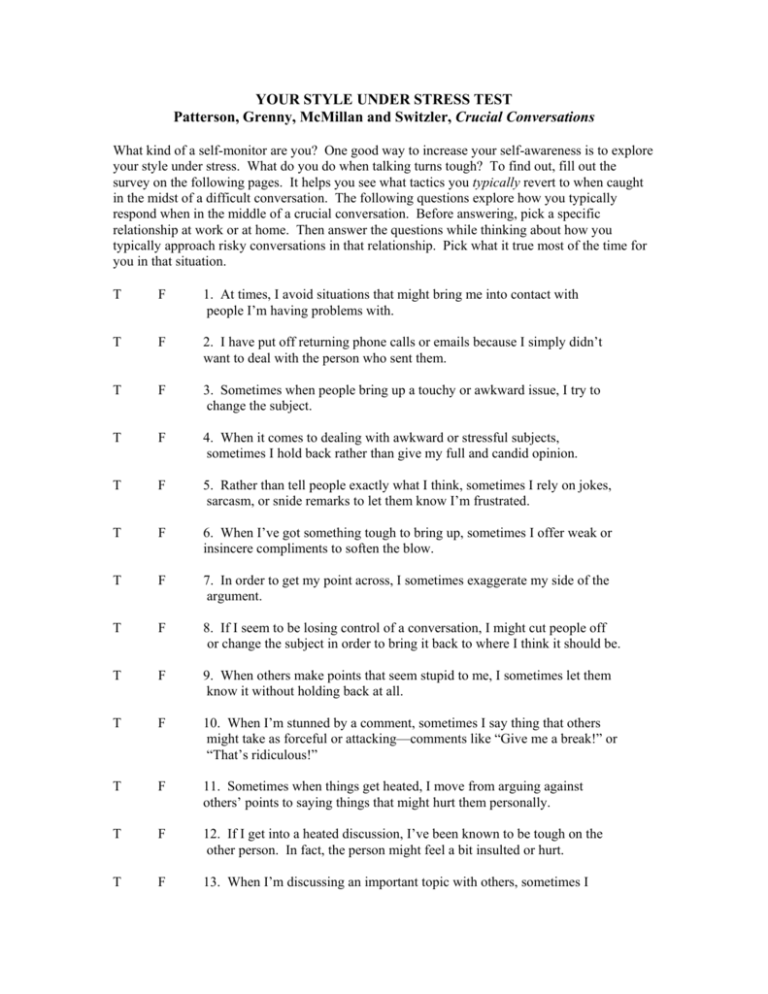
YOUR STYLE UNDER STRESS TEST Patterson, Grenny, McMillan and Switzler, Crucial Conversations What kind of a self-monitor are you? One good way to increase your self-awareness is to explore your style under stress. What do you do when talking turns tough? To find out, fill out the survey on the following pages. It helps you see what tactics you typically revert to when caught in the midst of a difficult conversation. The following questions explore how you typically respond when in the middle of a crucial conversation. Before answering, pick a specific relationship at work or at home. Then answer the questions while thinking about how you typically approach risky conversations in that relationship. Pick what it true most of the time for you in that situation. T F 1. At times, I avoid situations that might bring me into contact with people I’m having problems with. T F 2. I have put off returning phone calls or emails because I simply didn’t want to deal with the person who sent them. T F 3. Sometimes when people bring up a touchy or awkward issue, I try to change the subject. T F 4. When it comes to dealing with awkward or stressful subjects, sometimes I hold back rather than give my full and candid opinion. T F 5. Rather than tell people exactly what I think, sometimes I rely on jokes, sarcasm, or snide remarks to let them know I’m frustrated. T F 6. When I’ve got something tough to bring up, sometimes I offer weak or insincere compliments to soften the blow. T F 7. In order to get my point across, I sometimes exaggerate my side of the argument. T F 8. If I seem to be losing control of a conversation, I might cut people off or change the subject in order to bring it back to where I think it should be. T F 9. When others make points that seem stupid to me, I sometimes let them know it without holding back at all. T F 10. When I’m stunned by a comment, sometimes I say thing that others might take as forceful or attacking—comments like “Give me a break!” or “That’s ridiculous!” T F 11. Sometimes when things get heated, I move from arguing against others’ points to saying things that might hurt them personally. T F 12. If I get into a heated discussion, I’ve been known to be tough on the other person. In fact, the person might feel a bit insulted or hurt. T F 13. When I’m discussing an important topic with others, sometimes I move from trying to make my point to trying to win the battle. T F 14. In the middle of a tough conversation, I often get so caught up in the arguments that I don’t see how I’m coming across to others. T F 15. When talking gets tough, and I do something hurtful, I’m quick to apologize for mistakes. T F 16. When I think about a conversation that took a bad turn, I tend to focus first on what I did that was wrong rather than focus on others’ mistakes. T F 17. When I’ve got something to say that others might not want to hear, I avoid starting out with tough conclusions, and instead start with facts that help them understand where I’m coming from. T F 18. I can tell very quickly when others are holding back or feeling defensive in a conversation. T F 19. Sometimes I decide that it’s better not to give harsh feedback because I know that it’s bound to cause real problems. T F 20. When conversations aren’t working, I step back from the fray, think about what’s happening, and take steps to make it better. T F 21. When others get defensive because they misunderstand me, I quickly get us back on track by clarifying what I do and don’t mean. T F 22. There are some people I’m rough on because, to be honest, they need or deserve what I give them. T F 23. I sometimes make absolute statements like “The fact is…” “It’s obvious that…” to be sure I get my point across. T F 24. If others hesitate to share their views, I sincerely invite them to say what’s on their mind, no matter what it is. T F 25. At times I argue for my view---hoping to keep others from bringing up opinions that would be a waste of energy to discuss. T F 26. Even when things get tense, I adapt quickly to how others are responding to me and try a new strategy. T F 27. When I find that I’m at cross purposes with someone, I often keep trying to win my way rather than looking for common ground. T F 28. When things don’t go well, I’m more inclined to see the mistakes others made than notice my own role. T F 29. After I share strong opinions, I go out of my way to invite others to share their views, particularly opposing ones. T F 30. When others hesitate to share their views, I do whatever I can to make it safe for them to speak honestly. T F 31. Sometimes I have to discuss things I thought had been settled because I don’t keep track of what was discussed before. T F 32. I find myself in situations where people get their feelings hurt because they thought they would have more of a say in final decisions than they end up having. T F 33. I get frustrated sometimes at how long it takes some groups to make decisions because too many people are involved. SCORING YOUR STYLES UNDER STRESS SHEETS Patterson, Grenny, McMillan and Switzler, Crucial Conversations (McGraw, 2002) Please fill out the score sheets below. Each domain contains 2-3 questions. Next to the question number is either a T or F. For example, under Masking, question 5, you’ll find a T. This means that if you answered it True, check the box. With question 13 on the other hand, you’ll find an F. Only check that box if you answered the question false---and so on. Your Style Under Stress score will show you which forms of silence or violence you turn to most often. Your Dialogue Skills score is organized by concept so you can decide which skills you need more work on at present. STYLE UNDER STRESS BOX SILENCE Masking ( ) 5 (T) ( ) 6 (T) Avoiding ( ) 3 (T) ( ) 4 (T) Withdrawing ( ) 1 (T) ( ) 2 (T) VIOLENCE Controlling ( ) 7 (T) ( ) 8 (T) Labeling ( ) 9 (T) ( ) 10 (T) Attacking ( ) 11 (T) ( ) 12 (T) Meaning: Your silence and violence scores give you a measure of how frequently you fall into this lessthan-perfect strategies. It’s actually possible to score high in both. A high score (one or two checked parentheses per domain) means you use this technique fairly often. It also means you’re human. Most people toggle between holding back and becoming too forceful. SCORE SHEET FOR DIALOGUE ASSESSMENT SKILLS Start with Heart: what do I really want? State my path: can I talk through difficult ( ) 13 (F) moments? ( ) 19 (F) ( ) 17 (T) ( ) 25 (F) ( ) 23 (F) ( ) 29 (T) Learn to look: can I spot crucial Explore others’ paths: can I listen to conversations, loss of safety? others’ points of view? ( ) 14 (F) ( ) 18 (T) ( ) 20 (T) ( ) 24 (T) ( ) 26 (T) ( ) 30 (T) Make it safe: can I create safe space? Move to action: can I move to decisions? ( ) 15 (T) ( ) 31 (F) ( ) 21 (T) ( ) 32 (F) ( ) 27 (F) ( ) 33 (F) Master my stories: can I self-diagnose and alter my story? ( ) 16 (T) ( ) 22 (F) ( ) 28 (F) Meaning: If you score high (two or three boxes in each domain), you’re already quite skilled in this area. If you score low (zero or one), you may want to pay attention and develop more in these areas.
